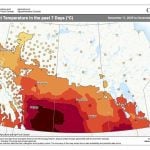After a colder-than-average winter, followed by a colder-than-average start to spring, most of us across Manitoba were hoping April would break out of this cycle. It didn’t.
Unless you spent every waking minute inside, it was just plain cold in April. Similar to March, we didn’t see record-breaking cold. It was just consistently cold.
I’m scratching my head about the lack of a deep ground freeze. It was a cold winter and spring, and snow cover was not that deep, but there wasn’t much frozen ground anywhere that I checked this spring.
Read Also

Farmer gift idea: How about a weather station?
The 2025 holiday season is looming, and a home weather station might make a great Christmas gift for farmers
Please feel free to let me know if you noticed this where you are, or if you have an explanation as to why. I have a couple of theories, but I am interested in what you may think. You can contact me at [email protected].
How cold was April across the Prairies? Let’s begin our look in Alberta. Typically, we would expect Alberta to be warmer than the rest of the Prairies in winter, but once April rolls around, this begins to change.
Average April temperatures across the Prairies are similar, with all major locations seeing mean monthly temperatures in the 4 to 5 C range. Once we move into May and June, Alberta becomes the cool spot, with Manitoba becoming the hot spot.
That said, compared to average, Alberta was the hot spot this year across the Prairies, though still slightly below the long-term average. All three of the main locations I use to represent this region (Calgary, Edmonton, Peace River) reported mean monthly temperatures between 0.3 and 0.8 C below the long-term average.
So, while this is below average, anything within plus or minus 0.5 C of average I consider to be near average.
These near-average temperatures did not come with much precipitation. Calgary and Peace River reported less than five millimetres of precipitation in April. Edmonton was the wet spot with about 15 mm, but even this is only about 50 per cent of average. Overall, it was a near-average month for temperatures across Alberta, with below to well-below average precipitation.
Saskatchewan saw the same temperature pattern as it did in March: cold. Mean monthly temperatures were between 0 and 1 C, which is 4 to 5 C below the long-term average. Precipitation in Saskatoon was well-below average with only about eight mm recorded compared to the long-term monthly average of 23 mm. Regina, thanks to a late April storm system, came in a little closer to average, with about 20 mm of precipitation compared to the average of 24 mm.
Overall, Saskatchewan experienced well-below average temperatures with near- to below-average precipitation over northern and western regions with near- to above-average amounts over south-central regions.
Last, but not least, Manitoba. We already know it was colder than average, but by how much? It turns out we were not quite as cold as Saskatchewan, though nearly. Mean monthly temperatures in Winnipeg and Brandon were between 0 and 1 C, just like they were in Regina and Saskatoon, but Manitoba’s mean monthly temperatures are just a little cooler, which meant these two locations were between 3 and 4 C below average.
Dauphin was the warm spot, with a mean monthly temperature right around 1.5 C, about 2 C below average.
April precipitation across agricultural Manitoba was a bit of a mixed bag, thanks to a couple of storm systems that brought significant precipitation to some regions. Brandon was the wet spot, with about 26 mm, which is average for the month. Winnipeg reported about 15 mm, which is about 50 per cent of average, and Dauphin only reported 10 mm, about 33 per cent of average.
Overall, it was a cold and drier-than-average month with the exception of extreme southern regions, which saw near to slightly above average precipitation.
Who called it?
Looking at the weather predictions for April, I would have to give the win to the National Oceanic and Atmospheric Administration. It called for below-average temperatures in Manitoba and Saskatchewan with near-average in Alberta. It called for near-average precipitation with Manitoba possibly seeing above-average amounts.
I name myself second runner-up, with a call of below-average temperatures and near- to below-average precipitation.
Let’s see if any of the computer-based weather models have changed their tunes for the upcoming months. As usual, we will start with the almanacs. Since they create their forecasts only once a year, nothing will have changed, but in case you have forgotten, the Old Farmer’s Almanac calls for warmer- and wetter-than-average conditions in May, followed by warm and dry weather in June.
The Canadian Farmers’ Almanac calls for near-average temperatures and precipitation in both May and June, a lot of fair weather and several chances of showers and unsettled weather.
As for the weather models, NOAA’s latest forecast calls for near-average temperatures in May and June along with near-average precipitation in southern Manitoba and Saskatchewan and below-average amounts in southern Alberta.
The CFS model calls for above-average temperatures in May and June, with below-average precipitation in May and near-average amounts in June. The CanSIPS model calls for near-average temperatures and precipitation in both May and June.
Finally, my forecast or prediction. I am sticking to my forecast of near-average temperatures in May, with above-average temperatures in June. Precipitation is always the toughest, but I’m going to go with the CFS model, which calls for below average amounts in May and near average in June.
















